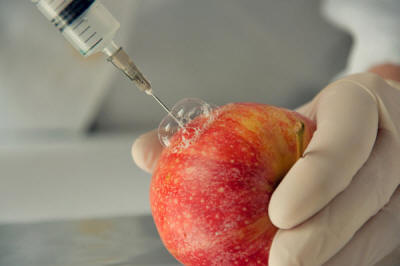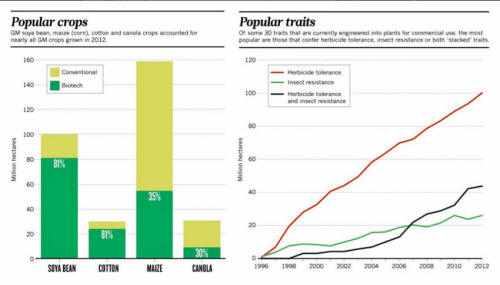Thirty years ago, scientists figured out how to directly modify the genes in our food crops. No more of that inefficient and slow breeding!
Farmers would grab plant genes by the horns nucleotides and bend them to their will!
Now, the preeminent science journal Nature has devoted an entire issue to the question (to paraphrase that legendary IBM ad), where are the magic seeds? We were going to get seeds that would grow faster, yield more, save the environment, and be more nutritious.
What we got were seeds for a few commodity crops such as corn, soy, and cotton that made their own pesticide or resisted herbicides, but otherwise provided little, if any, benefit to consumers.
Nonetheless, Nature assures us that the magic seeds are on the way. What the journal doesn’t say explicitly, however, is that there’s evidence that for existing GMO seeds, the best days are already over - and the next generation of seeds may be doomed even before they’re in the ground.
Of course, you’ll have to forgive the large biotechnology companies like Monsanto and Syngenta for thinking that they did in fact supply magic seeds.
After all, as Nature observes, every year, farmers worldwide plant $15 billion worth of GMO seeds, covering about 420 million acres - an area larger than Texas and California combined - much of it on U.S. land. And those biotech companies earned tens of billions in profits off of them.
It’s an undeniably impressive feat.
Just look at these charts of GMO adoption by farmers:
But popularity ≠ sustainability.
What about charts that demonstrate GMOs’ vaunted yield increases and environmental benefits? Not to be found.
That’s probably because, for all their marketplace success, it’s very difficult to measure exactly how much GMOs have increased crop productivity. One recent USDA study even found that yields for some GMOs were lower than for their conventional counterparts, though they did decrease the overall risk of crop failure.
In fact, if you look at charts of corn yields over time, what you see amid the volatility is a pretty consistent, modest trend that began in the 1930s with the introduction of conventionally bred hybrid seeds.
You can’t look at the chart and guess when GMO seeds were introduced (hint: 1996) by some 'huge increase' in the yield curve.
Certainly, it’s not the way you could glance at a graph of, say, the tuberculosis death rate in the 20th century and instantly identify the date antibiotics were introduced.
The commercialization of GMO seeds starting in 1996 didn’t lead to any agricultural great leap forward. It’s a far cry from what biotech advocates declare: that we need GMOs in order to feed a growing world population or face mass starvation.
As for environmental benefits, Nature was unable to cite any independent assessment.
One article [sub req'd] quotes a single industry-funded study which determined that between 1996 and 2011, GMOs drove a 6 percent drop in pesticide on cotton crops, while overall the technology offered about a 9 percent improvement to the “environmental impact quotient” - a measure that takes into account impacts on wildlife and so on.
And the price for this very modest “progress”?
We’ve handed over the seed industry - and in a meaningful sense, the agricultural system - to a handful of large companies. In 2010, 85 percent of all corn and 92 percent of soy planted in the U.S. contained Monsanto’s patented genetically modified traits. It doesn’t quite seem worth it.
But even that modest formulation of GMOs’ benefit may be overstating the case.
As author Sam Fromartz put it in an essay on the Atlantic, GMOs have actually accelerated agriculture’s decline into unsustainability because:
… we’ve used them bring down the cost of industrial meat production and incentivize a transition to a meat-centric diet.
The loss of calories that result from feeding grains to animals instead of humans represents the annual calorie needs of more than 3.5 billion people, according to the UN Environmental Program.
In short, GMOs arguably are making matters worse by fueling the production of more animal feed and food-competing biofuels.
And, yes, agrees Nature, they’ve also driven the rise of superweeds that are immune to the effects of common herbicides central to GMO agriculture.
It’s this now-established fact that threatens GMOs’ meager benefits.
While farmers enjoyed a 15-year window of reduced pesticide use thanks to seeds that make their own or resisted the effects of others, superweeds and superbugs are now causing farmers to increase pesticide use.
In an op-ed in Food Safety News, agricultural scientist Charles Benbrook makes this very point, often overlooked by writers who cover the subject. He notes that compared to the early years of GMOs, farmers now must use twice as much herbicide, and seeds that emit multiple pesticides, to get the same amount of growth as GMOs used to achieve.
Benbrook observes that the growing pest and weed problems for GMOs have caused farmers to turn to seeds that are coated with a different pesticide - a neonicotinoid. If that name rings a bell, it’s because these pesticides that have been implicated in the increasing epidemic of bee deaths.
He also reveals something that I have not previously heard - that there has recently been what he calls a “historically unprecedented” 10-fold increase in fungicide use on U.S. crop acres, most of which are planted with GMO corn and soy.
So much for those GMO environmental benefits.
And that’s aside from the evidence that biotech’s “next big thing” - seeds that emit multiple pesticides - may be doomed to fail.
An international team of researchers, including USDA and biotech scientists, found what they termed “cross-resistance” to these pesticides in bugs exposed to the next-generation GMO seeds. Evidence, in other words, that GMO seeds are hitting a bug-covered wall.
But never mind all that! Nature wants to assure us that we need to remain committed to genetically modified food because the long-promised “jetpack era” - the one we’ve supposedly all been waiting for - is almost upon us.
It’s a familiar refrain:
Don’t mind the paltry benefits so far; the genetically modified best is yet to come!
If only the public is willing to eat it, that is.
And it’s the public that Nature identifies as a big part of the problem, as those pesky humans constantly throw up roadblocks to the latest engineered foods. (Witness yet another state referendum on GMO labeling, this time in Washington state.)
Consumers, with what the Nature editors declare are their “fears of the unfamiliar,” truly loom as the bad-guy in this debate.
Nature’s exploration of GMOs, which, given the journal’s - heh - “nature,” understandably restricts its focus to the science, ends up misinterpreting public distrust in GMOs.
You can’t understand the GMO debate without factoring in the political and corporate system in which it takes place. It’s like considering the causes of obesity without addressing the role of food marketing - obesity is not just about people on their own making bad choices.
GMOs didn’t come to dominate our agricultural system simply because they’re awesome, and they’re not struggling for acceptance because the public is fearful and/or misinformed.
Corporations made billions on GMOs and all we got was ethanol and an unsustainable diet.
Is it so surprising that we’re skeptical that the next time around will be any different?



